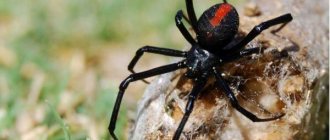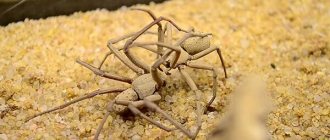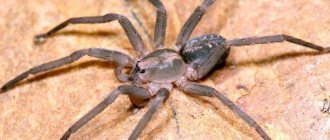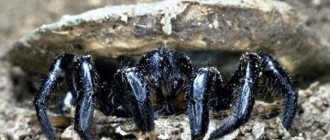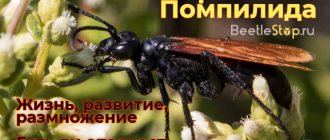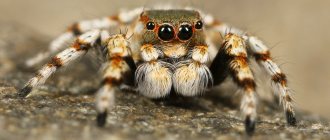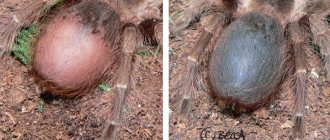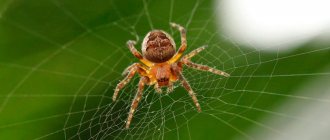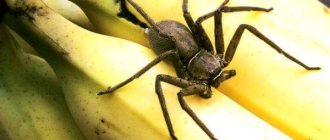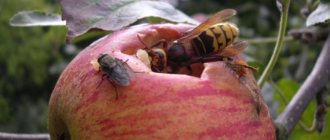Some people believe that spiders are insects. However, it is not. Spiders are classified into a separate class, and their body structure has some peculiarities. For example, insects always have three pairs of limbs. Spiders have one more, that is, four. The differences also apply to the eyes. In insects they are compound, but in spiders they are singular, with lenses. Representatives of one class can be distinguished from another by the presence of antennae. Spiders don't have them.
As a rule, arthropods cause disgust and fear in many people. And this despite its relatively small size. However, those spiders that live behind our cabinets and weave webs do not pose any danger to humans. But there are also representatives of this class living on Earth that should be avoided. These arthropods are terrible for humans. What are they, where can you see them? Let's look at the top most dangerous spiders in the world. And let's start with the most poisonous representatives.
Brazilian spider
This representative of arthropods is the most dangerous on our planet. For this reason, it was even included in the Guinness Book of Records. With him we begin the top 10 most dangerous spiders in the world.
Where does he live? The Brazilian wandering spider can be seen in the American tropics or subtropics. At the same time, two groups of these representatives of the animal world are distinguished. The first of these includes jumping spiders. They are called so by the way they pursue the victim. These spiders catch up with their prey using jerky jumps.
The second group includes running arthropods. These Brazilian spiders are very fast in pursuit of their prey. Representatives of the second group go hunting at night. During the daytime they hide under stones or in places where they cannot be seen. Such spiders can live both on the ground and in trees.
Why are these arthropods called wandering? The fact is that the Brazilian spider does not weave a web like its relatives. He constantly changes his place of residence, moving in search of food.
The most dangerous spider on our planet causes a lot of trouble for residents of South America. This poisonous creature gets into their homes. The Brazilian wanderer is often found in boxes of food or in closets with clothes.
What features does the most dangerous spider on our planet have? It is distinguished by its small size. The Brazilian wanderer can grow up to 10 cm in length. However, their small dimensions do not prevent these arthropods from being the most dangerous spiders in the world (see photo below).
They are excellent hunters and pose a great danger to humans. It is worth saying that the bite of this arthropod leads to suffocation, often resulting in death. The good news is that to save human life there is an antidote that should only be administered in time.
Of course, healthy adults do not have to worry about their lives after being bitten by the most dangerous spider on our planet. They can only have a strong allergic reaction to its poison. But toxins that enter the body of a child or a sick person can lead to the most tragic results.
What does the most dangerous spider on our planet prefer to eat? His favorite treat is bananas. That is why Brazilian wanderers prefer to climb into the boxes in which these fragrant fruits are stored. For such love, this representative of arthropods is often called the “banana spider.” However, the main food for him, of course, is not fruit at all. The most dangerous spiders in the world (see photo below) hunt insects.
Even relatives of other species become their victims. In addition, Brazilian wanderers attack birds and lizards, which are significantly larger than them.
The most dangerous spiders in the world do not attack people. They bite humans only for the purpose of their own protection.
Behavior of the redback spider.
Redback spiders are secretive, nocturnal arachnids. They hide in dry places under sheds, in old barns, among stacked firewood. Spiders live under rocks, logs, or among short plants.
There is an expressive red spot on the back of the spider
Like most spiders, females weave unique webs woven from strong threads; males are not able to create trapping networks. The web structure looks like an irregular funnel shape. Redback spiders sit motionless in the back of the funnel most of the time. It is built in such a way that the spiders feel the vibration that occurs when prey falls into the trap.
During the cold winter months in Japan, spiders go into torpor. This behavior has not been observed in any other part of the world where these spiders live.
Redback spiders are sedentary animals and prefer to stay in one place. Young spiders disperse with the help of a web thread, which is picked up by the air flow and carries them to new habitats.
Red-backed spiders use red markings on the carapace to warn predators of their poisonous nature. But it is not at all surprising that such dangerous spiders have natural enemies who attack and devour poisonous spiders. These predators are white-tailed spiders.
Sandy six-eyed
Representatives of these arthropods continue to make the top 10 most dangerous spiders in the world. These are small individuals, reaching a length of 8-15 mm. Outwardly, such spiders resemble crabs. This resemblance is given to them by the relatively large legs bent at the knees, the length of which reaches 50 mm. The slightly flattened shape of the arthropod’s body also resembles a crab. This most dangerous spider (photo below) received its name because of its inherent shade of brown color and the presence of six eyes.
The habitats of the sand six-eyed are the territories of South Africa and the lands of South America. Depending on the area where they live, these spiders have different concentrations of the deadly substance in their saliva. Thus, African individuals are endowed with more lightning-fast and deadly poison than their American relatives. Perhaps the reason for this lies in the climatic characteristics of the Namib Desert.
The six-eyed sand spider hunts for small insects. Larger scorpions also become its victims. The spider waits for its prey, buried in the sand. The hairs located on the body help it in camouflage. Grains of sand stick to them, making the hunter a successful conspirator.
The venom of this spider affects the body of its victim in an unusual and unique way. A toxin still unknown to science negatively affects blood vessels, destroying their walls. This process occurs due to slow necrosis. The victim's blood also has a detrimental effect. It begins the active destruction of red blood cells. Thus, the venom of this arthropod is a very effective killing weapon. Fortunately, encounters between the six-eyed sand spider and humans are very rare. Only two cases of death resulting from an attack by this arthropod have been recorded.
How it weaves a web and what it eats
Funnel spiders weave a dense horizontal web that converges downwards in the shape of a funnel. The network is supported by vertical support threads. It is not sticky, but loose: when small insects fall on it, they drown and cannot get out.
The upper horizontal part of the web passes into a camouflaged lower part, which turns into a predator’s refuge - a tube that envelops the mink. There the spider waits for a signal, after which it runs out and bites the victim. He takes the prey to his burrow and eats it there (more precisely, sucks it out).
Spiders only catch frisky animals. If the prey freezes, the predator will first provoke it by twitching the web, and will wait patiently, but will not touch it right away.
Important! Some spiders may not have webs, but all have burrows.
Since the web quickly becomes clogged, spiders do not stay in one place for long. After 2–3 weeks they leave their burrows and look for another place to live.
For the most part, funnel-web spiders are active at night, and only Malthonica lehtineni can hunt both day and night. Funnel web spiders feed on a variety of (sometimes dangerous) arthropods. Their main prey are:
- chitinized flies;
- mosquitoes;
- cicadas;
- small spiders;
- honey bees;
- Orthoptera beetles;
- ants.
After the victim gets caught in the web, the predator runs out with lightning speed, launches chelicerae into the body and injects poison and enzymes that turn the victim’s insides into mush.
Funnel spiders do not chew the victim, they simply suck out the already processed insides, waiting for the enzymes to complete their work.
You will be interested to read about how and why a spider weaves a web.
Sydney funnel web spider
This representative of arthropods is small or medium in size. It was rightfully included at the top of the list, from which the top most dangerous spiders on our planet were compiled. The fact is that its bite can cause death.
The size of female Sydney funnel-web spiders ranges from 1.5 to 3 cm. Males are usually a centimeter smaller. The body color of these spiders has beige-brown and sometimes black shades. Two dark longitudinal stripes located on the back help to distinguish these arthropods from their relatives.
The habitat of the described spider is Australia. Most often it can be found in the state of New South Wales. This representative of the animal world likes to settle in forests, as well as in areas developed by people. Funnel web spiders often wander around backyards and can sometimes get into swimming pools. It is not advisable for people to come into contact with these arthropods, as they become aggressive when threatened.
The Sydney funnel web spider produces strong venom. Moreover, the toxic substance is produced by arthropods in large quantities. The danger of the spider also lies in its long chelicerae. These are a kind of “fangs” in which, near the tip itself, there are channels that remove poison. It is worth saying that the chelicerae of the Sydney spider are larger in size than those of the brown snake, which is also very dangerous to humans.
The venom of the Australian arthropod includes a component that acts on the nervous system of the victim. Getting into the human blood, it changes the functioning of all systems and organs. When bitten by males, even death cannot be ruled out. In 1981, scientists developed an antidote that eliminated the danger of death to humans. Since then, no fatalities from Sydney funnel-web spider bites have been recorded.
5.Agriope
Appearance
The body can reach 3-4 cm. Black color of the head with thick hairs. The abdomen is striped yellow and black, like a wasp. Long black legs with pale yellow rings
Habitat
It lives in central Russia and the south of Russia; in addition, there are about 150 species of these spiders and they are found almost anywhere
Symptoms
The bite site becomes red, swollen, and numb. The pain goes away within a few hours, the swelling goes away within 2-3 days
How to avoid a meeting
This spider is not very aggressive and does not bite unless you grab it with your hands.
Black Widow
The top 10 most dangerous spiders in the world continues with this small-sized representative of arthropods. The length of its body is only 1.5-2 centimeters. And although the females of these representatives of arthropods are twice as large as the males, they are also quite difficult to distinguish in natural conditions. Nevertheless, these are the most dangerous spiders, located almost at the top of the corresponding rating.
The Black Widow is in constant “mourning.” Only sexually mature adults have red hourglass markings on their abdomen. Young spiders have a light color. Their body is sometimes white or yellowish-white. The color becomes darker only with age. The body of these spiders acquires a black color only in the second or third month of life.
This most dangerous spider (see photo below) did not receive its “mourning” name by chance. The females of this arthropod are distinguished by cannibalism towards males.
The habitat of these spiders, as a rule, is Central Asian deserts and steppes. They are less common in the Caucasus, as well as in the Crimea.
The black widow, ranking third out of the 10 most dangerous spiders, prefers to hunt in recesses under stones, placing its snares at a small height from the ground. She also watches for victims in cracks and various openings, over squat plants and even in the thick of grape vines.
Representatives of these spiders go hunting at night. During the day, they prefer to hide in their shelters. The food for the black widow is usually insects. However, these spiders are not averse to dining on woodlice and their own relatives.
The bite of a black widow is dangerous to humans. This is especially true for older people and children. The poison, spreading throughout the body, causes severe muscle spasms. Also, after a black widow spider bite, weakness and headache, shortness of breath and increased salivation, vomiting, a feeling of anxiety and tachycardia appear. You can neutralize the poison by burning the bite site with a match. To eliminate the possibility of an allergic reaction, it is also advisable to take the victim to the hospital.
Other poisonous spiders of Russia
In the vastness of the Russian Federation, you can meet other representatives of arthropods that are capable, if not of killing a person with their bite, then of causing a lot of painful sensations.
- South Russian tarantula. The venom of this fairly large spider, reaching 30 mm in length, is not fatal to humans. However, the bite site swells very quickly and is very painful. An allergic reaction is possible in the form of rashes and redness of the skin, accompanied by itching and burning in places where the scratch is made.
South Russian tarantula - Heiracanthium. Tops the list of poisonous spiders in central Russia. Unlike the karakurt, it does not specifically attack and can bite only for the purpose of self-defense. The symptoms are quite unpleasant: a strong burning sensation at the site of the bite, nausea, vomiting, headache, fever, body aches, weakness. The bite site itself looks quite scary: it turns red, blue, and may even become covered with blisters. This condition can last up to 3 days. Seeing a doctor is mandatory.
Heiracanthium does not specifically attack people, but can bite in self-defense
- Phalanx (solfuga). One of the few spiders, after a bite it is recommended to suck the wound. It does not have its own toxic poison, but it will certainly cause an infection, causing the wound to become inflamed. It is active only in the dark, but does not bite on purpose, only as a defense.
Phalanx - Web spider. A rather small spider, it is dangerous, like the previous representative of arthropods, not by poison, but by the possibility of introducing infection into the wound.
Web spider
Bagworm (bag spider). This spider is aggressive enough to attack even in the absence of direct danger. The bite is not fatal, but is accompanied by very severe pain, which can spread very quickly throughout almost the entire body.
Pouch spider
• False black widow. First of all, it is dangerous because it often gets into living quarters. After the bite, acute, prolonged pain, weakness and fever are felt. Symptoms may last up to two days.
False black widow
- Black fathead. The most peaceful of dangerous spiders. If you don't touch him or pick him up, he prefers to hide. However, if it bites, the wound will hurt for at least a day.
Black fathead - Argiope. The bite of this striped spider is very dangerous. An allergic reaction to poison can result in deep and severe abscesses, deterioration of general condition and other unpleasant symptoms.
Argiope
As you can see, poisonous spiders are far from uncommon in Russia, but only the female karakurt should be greatly feared. You can easily cope with the consequences of bites from other arachnids on your own. However, seeing a doctor is highly recommended.
Red back
At first glance, the small spider looks very similar to a black widow. Its black color, red stripe on its back, and red-orange hourglass-like pattern on its abdomen give it its resemblance to this arthropod. However, this spider is not a black widow, since its homeland is Australia. Today, this arthropod can be found in countries such as Japan, Belgium and New Zealand.
The venom of the redback (a member of the karakurt family) is more dangerous than the venom of the rattlesnake itself. In this regard, a bite from a small spider can cause serious consequences for a person. After a toxic substance enters the bloodstream, people experience pain, muscle spasms, repeated bouts of nausea, and increased sweating. Fortunately, the main food for this spider is small insects, and sometimes even lizards. This dangerous little guy does not look out for people, and therefore such meetings occur very rarely.
Spread of the redback spider.
The redback spider is distributed throughout Australia. This species also lives in New Zealand (North and South Islands), and was introduced there by accident during the transportation of grapes from Australia. The habitat covers most regions of Southeast Asia and northern India. The redback spider has recently been spotted in southern and central Japan.
Australian redback spider (Latrodectus hasselti)
Chilean recluse spider
This arthropod is also one of the ten most dangerous on our planet. Its habitat is the western United States. You can meet the recluse spider in the states of Iowa, Nebraska, as well as Indiana and Texas. This is one of the largest arthropods of this species. The length of its body, including limbs, often reaches 1.5 inches. Translated from Spanish, the name of this representative of the animal world is “brown spider.”
Despite its small size, ranging from 6-20 millimeters, the bite of the Chilean hermit can cause painful death. Toxic substances contained in his saliva cause paralysis of all internal organs, as well as hemolytic anemia and severe renal failure.
6.Black fathead
Appearance
The body can reach 2 cm. Hairy, black head and paws (with white rings), red abdomen with black dots (in males)
Habitat
Lives in central Russia and the south of Russia, Crimea, and the Caucasus
I
A very painful bite. Numbness, swelling, stiffness of movement. These wonderful symptoms last for about a week.
How to avoid a meeting
This spider is not very aggressive and does not bite unless you grab it with your hands.
Spider mouse
This most dangerous creature is found in Chile and Australia. This representative of arthropods got its name due to the erroneous opinion of people that spiders, like mice, live underground in burrows they dug.
The size of this poisonous representative of the animal world is very small. The length of its body ranges from one to three centimeters.
The victims of mouse spiders are insects. They also eat other spiders. In turn, these arthropods feed on scorpions, wasps, labiopods and bandicoots.
The venom of the mouse spider is of protein origin and is considered very dangerous to humans. Fortunately, its individuals are rarely found near human habitation. In addition, the mouse spider prefers to save its venom by making so-called dry bites.
Brown Widow
Like its brethren, the brown widow produces a neurotoxic venom that can cause a variety of symptoms known as latrodectism.
The Brown Widow has relatively thin legs and a deep, spherical abdomen. On the abdomen there are one or more red spots on the top or bottom. The spots may be shaped like an hourglass or several dots. Males are much smaller than females and less dangerous, but they can also bite.
Brown widow venom causes painful effects including muscle spasms, "tetanus" contractions, and in rare cases, spinal or cerebral palsy. It is usually temporary but can cause permanent damage to the central nervous system. The effects of the bite may require a short hospital stay. Children, elderly and sick people are more likely to suffer serious consequences.
Chinese tarantula
This spider is classified as one of the varieties of the large tarantula. The length of its body is about twenty centimeters. You can meet arthropods of this species in Vietnam and China. Due to their inherent size and ferocious appearance, locals call these spiders earth tigers.
The venom of the Chinese tarantula has been studied in laboratory conditions. Experimental results have proven that toxic substances released by these arthropods lead to the death of small mammals in fifty percent of cases.
Description
The body length of males is 8-11 mm, and that of females is 12-16 mm. The subspecies living in the south of the range are larger. Their length can reach 20 mm. There is pronounced sexual dimorphism.
In males, the cephalothorax is black and covered with dense hairs, and the abdomen is bright red, scarlet or orange. There are 4 black round spots visible on it. In most subspecies they are bordered with white. There are whitish rings on the two front legs, and reddish ones on the two hind legs.
Females have a solid black-brown or black color. There are only slightly marked thin light lines on the limbs. Its back is densely covered with hairs.
There are 8 small eyes in the head area. Four are located on the forehead, and the rest on the sides of the head. Chelicerae are well developed in both sexes. They end in poisonous claws.
In the wild, the life expectancy of black fatheads does not exceed 2 years. In laboratory conditions they can live up to 3 years.
Source
Sak
What are the most dangerous spiders in tenth place in the presented ranking? These arthropods are called golden or golden ones. We are talking about yellow saka spiders, which live mainly in Europe. This small (up to 1 cm in length) arthropod builds itself a bag-like shelter. Sometimes sakis simply sit out inside their house. The bites of these spiders are clinically dangerous and cause extensive tissue necrosis. However, fortunately, golden sakis are not at all aggressive. They can attack people only when there is a feeling of danger.
HORN Dweller
Black eresus lives in sunny, dry places, in forests, in the steppe zone, on the outskirts of heathlands, in dry pastures, alpine meadows and even in deserts and salt marshes. The favorite food of these spiders is beetles, but the black fathead does not disdain flies, butterflies and mosquitoes if they are caught in the web.
Fatheads hunt using a web trap. The lower part of this cunning structure is a hole with a diameter of about 1 cm, sometimes quite deep, up to 10 cm. The spider lives in it. As a rule, he digs it out in the ground or under large stones, but often instead masters the passages of rodents. The eresus weaves a web around the hole so that it looks like a tube. Not far from it, on the ground or low grass, the fathead constructs a trapping net in the form of a canopy. There are no adhesive threads in it, but it is made of a special ultra-thin, messy web that is easy to get tangled in. The network of the thickhead is so strong that it can hold even large beetles - darkling beetles and dung beetles. It is connected to the web tube by several signal threads, the vibrations of which inform the spider that a victim has fallen into the trap. It quickly jumps out, grabs its prey and paralyzes it with poison. Eresus throws out the remaining food from the hole or puts it in a special hole.
Funnel spider (grass spider) - description and photographs
These are medium-sized spiders: from 6 to 21 mm in leg span, with an oval abdomen and a pear-shaped or ovoid unflattened carapace (dorsal part of the shell). Females are larger than males, but the carapace of many males is larger than that of females.
The funnel web spider's body color ranges from light brown or beige-brown to black. The body is covered with feathery hairs. Most agelenid species have a pattern on the abdomen and carapace. The front pair of legs is always longer than the others. The legs themselves are covered with powerful spines and sensilla. The paws of the legs are equipped with three claws, which indicates the ability of funnelworms to weave webs. The claws are covered with spines, the number and location of which serves as a taxonomic feature.
Photo credit: Donald Hobern, CC BY 2.0
Representatives of the family have 6 simple and 2 complicated eyes. They are approximately equal in size and are usually located in pairs at almost the same distance from each other. Tunnel spiders have poor vision, so they navigate more using their sense of touch (motion sensors on their front legs). The chelicerae are powerful and directed downwards.
On the underside of the abdomen there are 2 pairs of arachnoid warts, the front ones are widely spaced, and the rear ones are elongated and often protrude backwards, resembling tails. One straight spiracle opens in front of the arachnoid warts. Funnel web spiders breathe with the help of two lungs and a pair of tracheas.
Photo credit: Donald Hobern, CC BY 2.0
